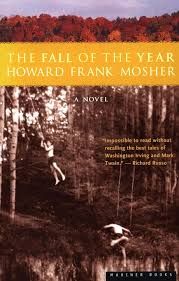The Fall of the Year (1999) by Howard Mosher
Good Reads meta-data is 288 pages, rated 4.11 by 409 cinematizens.
Genre: Non-Fiction; Species: Mountain magic.
DNA: Vermont.
Verdict: More, please.
Tagline: ‘Very little that people do is in any way understandable!’

Adopted orphan boy Frank Bennett grows up in Kingdom Country (Vermont) along the unmarked Canadian border in the household of an acerbic Catholic priest (who does not sexually abuse him despite his dog collar). Father George is the recognised but unofficial historian of the locale and the designated peacemaker among the many ley lines of conflict that riven the village.
Frank’s coming of age is told in episodes in which he participates, often as little more than an observer of the absurdity of life and its satisfactions. The telling is timeless but perhaps the early 1950s.
While the bulk of the small population is steadfastly safe and sane, shopping at the Vermont Country Store and voting for Bernie Sanders, within their ranks are eccentrics like young Molly Murphy and her desperate and eventually successful effort to run away and join the circus where her nerveless dare devilry can thrive. More troublesome is Foster Boy Dufresne, an idiot savant if ever there was one, who seems jinxed starting with that name ‘Foster Boy.’ Then there is the wannabe gypsy fortune teller Louvia de Banville who has a bad word to say for and about everyone and yet is always there to help when help is needed in fire, flood, accident, or worse.
Aside from the Irish and the Canucks, the village is also home to Abel Feinstein, a tailor, who will not take one step back and Sam E. Rong who took the Statue of Liberty’s motto literally.
Frank long wanted to follow Father George into the priesthood, but, well, there is that girl with bluest, dancing eyes who teases him mercilessly and then disappears back to Quebec for months at a time.

It is not Lower Rising, Staggerford, Lake Woebegon, or Yoknapatawpha county, and certainly not Mayberry, but it is its very own God’s little acre. Mosher published ten novels set in this cleft between the Green and White Mountains where on some nights the bright lights of Montreal can be seen reflected in low clouds; where the endless forests are dark and primeval; the lakes crystalline; and weather as taxing as the people.

